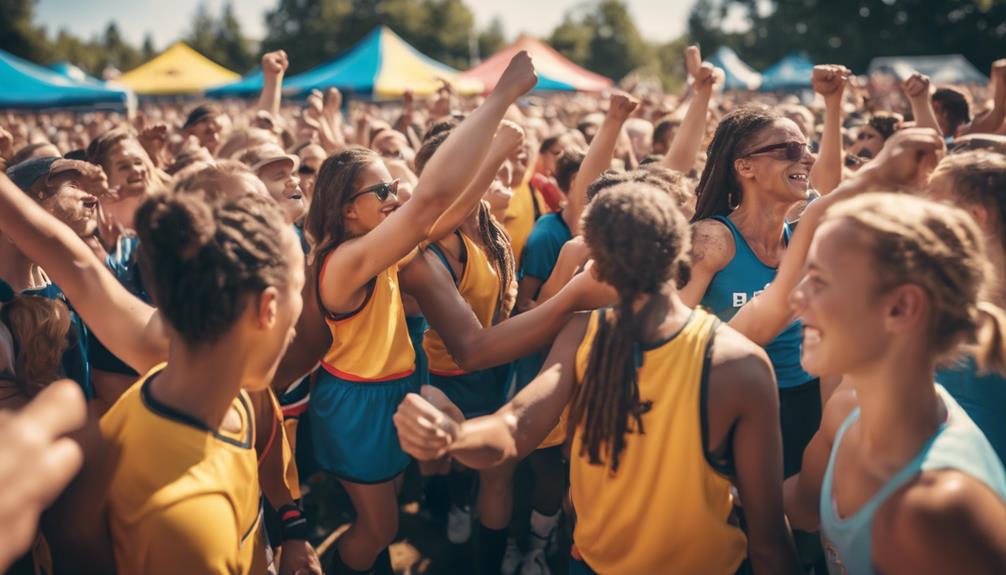
Cheerleading has long been a topic of debate when it comes to its classification as a sport. While many view it as simply a way to rally the crowd for a football game or a basketball match, there’s a much deeper story beneath the pom-poms and spirited chants. This article aims to break down the various aspects that firmly place cheerleading within the realm of sports. From athletic requirements to mental challenges, we’ll explore why cheer deserves recognition as a legitimate sport.
1. What Defines a Sport? Let’s Break It Down
To understand why cheer is a sport, we first need to clarify what defines a sport. Typically, a sport involves physical exertion, competition, and a structured set of rules. It requires skill, strategy, and teamwork. By this standard, cheerleading ticks all the boxes. Cheerleaders perform intricate routines that necessitate not only physical strength but also coordination, timing, and creativity, all of which are essential elements of sports. Is Sports Tape WaterproofWhat Happened To Pro Sports Daily WebsiteIs Frisbee Golf A Sport
Moreover, many sports have evolved to incorporate elements of entertainment, and cheerleading is no exception. Like gymnastics or figure skating, cheer routines are judged based on performance quality, execution, and creativity. This further solidifies cheerleading’s status as a sport because, at its core, it combines athleticism with artistry—a hallmark of many recognized sports.
2. The Athleticism of Cheerleading: More Than Just Cheers
When most people think of cheerleading, they picture energetic chants and catchy slogans, but cheerleading is so much more than that. The athleticism involved in cheerleading is astonishing. Cheerleaders execute challenging stunts, flips, and pyramids that require incredible strength and agility. These athletes undergo rigorous training, focusing not just on dance moves, but also on acrobatics and gymnastics.
This high level of physicality distinguishes cheerleading from mere crowd support. The ability to lift teammates high into the air, perform complex tumbles, and maintain perfect timing in routines showcases the athletic prowess of cheerleaders. It’s a demanding activity that pushes the limits of physical capability and body control, akin to what you would find in traditional sports.
3. Skills and Training: Cheerleaders Are Serious Athletes
Becoming a cheerleader isn’t as simple as learning a few cheers; it demands significant skill and extensive training. Cheerleaders practice regularly, often spending several hours a week honing their techniques and perfecting their routines. They train in areas such as gymnastics, dance, and strength conditioning, ensuring they are well-prepared for the physical challenges of their sport.
Furthermore, cheerleading requires a unique set of skills that combine dance, acrobatics, and precise timing. From jumps and stunts to choreography and formations, cheerleaders must master a diverse skill set. This dedication and training reflect the commitment typically associated with athletes in other sports, reinforcing the notion that cheerleading is indeed a sport.
4. The Importance of Teamwork in Cheerleading Success
Teamwork is a cornerstone of cheerleading, just as it is in many recognized sports. Cheerleaders function as a cohesive unit, relying on one another to execute complicated stunts and routines successfully. Each member plays a specific role, whether it’s being a base, flyer, or spotter, and their ability to work together can make or break a performance.
The synchronization required in cheerleading fosters strong bonds among teammates. Trust and communication are vital; when a flyer is lifted high into the air, they must trust that their bases will catch them safely. This level of collaboration is essential and mirrors the dynamics seen in sports like basketball or soccer, where teamwork is critical for achieving a common goal.
5. Competitions and Rankings: Cheer’s Competitive Edge
Cheerleading isn’t just about rallying the crowd; it’s a fiercely competitive endeavor. Cheer teams participate in numerous competitions throughout the year, striving for top rankings in their division. These events feature teams from various regions, and the competition can be intense. Judges evaluate routines based on difficulty, execution, synchronization, and overall performance quality.
The competitive nature of cheerleading mirrors other sports, where teams train for titles and trophies. Many cheer squads dedicate countless hours to preparing for these competitions, showcasing their hard work and talent in front of judges and spectators. This competitive aspect elevates cheerleading to the level of sport, contributing to its legitimacy in the athletic community.
6. The Physical Demands: Strength, Stamina, and Skill
Cheerleading is a physically demanding activity that requires a unique blend of strength, stamina, and skill. Cheerleaders must excel in various physical attributes, from core strength to flexibility and endurance. The rigorous training and performances challenge their bodies in ways that are comparable to athletes in traditional sports like football or track and field.
Moreover, the physical necessity in cheerleading extends beyond strength. Cheerleaders must also demonstrate incredible balance and coordination, particularly when executing high-flying stunts or tumbling passes. The combination of these demands establishes cheerleading as a serious athletic pursuit, requiring dedication and hard work akin to that found in other sports.
7. Mental Toughness: The Mindset of a Cheerleader
Mental toughness is another significant aspect of cheerleading that solidifies its status as a sport. Cheerleaders face high-pressure situations, whether in competitions or during performances, where mistakes can be magnified in front of an audience or judges. This requires a resilient mindset and the ability to perform under stress—a common expectation in competitive sports.
Additionally, cheerleaders must embody discipline and focus, as routines often involve complex choreography that requires significant memorization and practice. The mental preparation and strategy involved in executing a perfect routine are comparable to what athletes in sports like gymnastics or swimming experience, further reinforcing cheerleading’s place in the sports arena.
8. Safety First: The Risks and Protocols in Cheer
Safety is a paramount concern in cheerleading, as it involves a high level of risk due to stunts and acrobatics. Recognizing this, cheer teams implement strict safety protocols and guidelines to minimize injuries. Coaches are trained to ensure that cheerleaders practice safe techniques, and many teams undergo certification to adhere to safety standards.
The awareness of safety measures mirrors that found in other sports, where injuries can be prevalent. Cheerleaders wear appropriate gear, such as mats and safety equipment, and must undergo training to identify and avoid unsafe practices. This focus on safety not only protects athletes but also emphasizes the seriousness of cheerleading as a sport.
9. The Evolution of Cheer: From Sidelines to Sport Lights
Cheerleading has evolved significantly over the years, transitioning from its origins as a supportive role on the sidelines to a competitive sport that commands its own stage. What was once seen as merely a form of entertainment has now developed into a serious athletic discipline with its own competitions, rules, and organizations.
This evolution reflects the growing recognition of cheerleading as a sport. Organizations like the Universal Cheerleaders Association and the National Cheerleaders Association have established guidelines and competitive formats, making cheerleading a structured and organized activity. This shift highlights the commitment and caliber of athletes involved, underscoring the importance of recognizing cheerleading as a legitimate sport.
10. Why Dismissing Cheer as a Sport Just Isn’t Fair
Dismissing cheerleading as merely a pastime undermines the hard work and dedication of countless athletes. Cheerleaders spend hours training, competing, and perfecting their craft, often sacrificing personal time and physical well-being to excel. Stereotyping cheer as "just cheering" fails to acknowledge the rigorous demands and challenges that come with the discipline.
By recognizing cheerleading as a sport, we celebrate the athleticism, teamwork, and commitment that all cheerleaders embody. Just like any other sport, cheerleading fosters community, instills discipline, and promotes healthy competition. Dismissing it would not only be unfair to the athletes but also to the spirit of sportsmanship itself.
In conclusion, cheerleading has proven itself to be a sport in every sense of the word. With its blend of athleticism, teamwork, competition, mental toughness, and safety protocols, it mirrors many of the qualities found in traditional sports. As society continues to evolve, so too should our understanding and acceptance of cheerleading as a legitimate sport. By recognizing and valuing these athletes for their hard work and dedication, we can foster a more inclusive view of what constitutes a sport in the modern world.





